
14 crossword puzzles related to 7th grade science.
- Subject:
- Life Science
- Physical Science
- Material Type:
- Homework/Assignment
- Author:
- Share My Lesson Science Team
- Date Added:
- 06/11/2021

14 crossword puzzles related to 7th grade science.
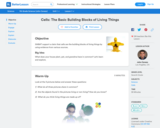
Objective
SWBAT support a claim that cells are the building blocks of living things by using evidence from various sources.
Big Idea
What does your house plant, pet, and grandma have in common? Let's learn and explore.
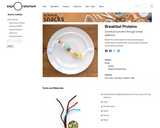
Construct a protein through cereal additions. Model the central dogma of molecular biology by constructing a colorful chain using a simple code (and some delicious cereal).
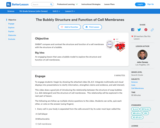
Objective
SWBAT compare and contrast the structure and function of a cell membrane with the structure of a bubble.
Big Idea
An engaging lesson that uses a bubble model to explore the structure and function of cell membranes.
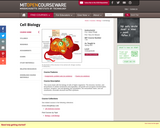
Biology of cells of higher organisms: structure, function, and biosynthesis of cellular membranes and organelles; cell growth and oncogenic transformation; transport, receptors and cell signaling; the cytoskeleton, the extracellular matrix, and cell movements; chromatin structure and RNA synthesis.
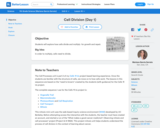
Objective
Students will explore how cells divide and multiply for growth and repair.
Big Idea
In order to multiply, cells need to divide.
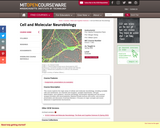
Subject covers all major areas of cellular and molecular neurobiology including excitable cells and membranes, ion channels and receptors, synaptic transmission, cell type determination, axon guidance and targeting, neuronal cell biology, synapse formation and plasticity. Includes lectures and exams, and involves presentation and discussion of primary literature. Focus on major concepts and recent advances in experimental neuroscience.
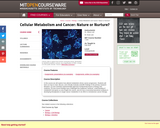
In this course we will explore how altered metabolism drives cancer progression. Students will learn (1) how to read, discuss, and critically evaluate scientific findings in the primary research literature, (2) how scientists experimentally approach fundamental issues in biology and medicine, (3) how recent findings have challenged the traditional “textbook” understanding of metabolism and given us new insight into cancer, and (4) how a local pharmaceutical company is developing therapeutics to target cancer metabolism in an effort to revolutionize cancer therapy.
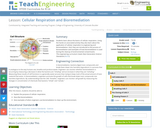
In this lesson, students learn about the basics of cellular respiration. They also learn about the application of cellular respiration to engineering and bioremediation. And, students are introduced to the process of bioremediation and several examples of how bioremediation is used during the cleanup of environmental contaminants.
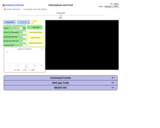
This simulation shows the relationship between the inputs and outputs in the chloroplasts of plants to help explain how they convert water and carbon dioxide to glucose and water with the help of energy absorbed from light. It is used in Lesson 5 of Unit 7.4 in the OpenSciEd curriculum.

In this lesson, students continue their education on cells in the human body. They discuss stem cells and how engineers are involved in the research of stem cell behavior. They learn about possible applications of stem cell research and associated technologies, such as fluorescent dyes for tracking the replication of specific cells.
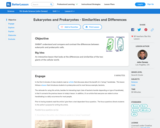
Objective
SWBAT understand and compare and contrast the differences between eukaryotic and prokaryotic cells.
Big Idea
An interactive lesson that looks at the differences and similarities of the two giants of the cellular world.
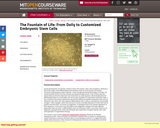
" During development, the genetic content of each cell remains, with a few exceptions, identical to that of the zygote. Most differentiated cells therefore retain all of the genetic information necessary to generate an entire organism. It was through pioneering technology of somatic cell nuclear transfer (SCNT) that this concept was experimentally proven. Only 10 years ago the sheep Dolly was the first mammal to be cloned from an adult organism, demonstrating that the differentiated state of a mammalian cell can be fully reversible to a pluripotent embryonic state. A key conclusion from these experiments was that the difference between pluripotent cells such as embryonic stem (ES) cells and unipotent differentiated cells is solely a consequence of reversible changes. These changes, which have proved to involve reversible alterations to both DNA and to proteins that bind DNA, are known as epigenetic, to distinguish them from genetic alterations to DNA sequence. In this course we will explore such epigenetic changes and study different approaches that can return a differentiated cell to an embryonic state in a process referred to as epigenetic reprogramming, which will ultimately allow generation of patient-specific stem cells and application to regenerative therapy. This course is one of many Advanced Undergraduate Seminars offered by the Biology Department at MIT. These seminars are tailored for students with an interest in using primary research literature to discuss and learn about current biological research in a highly interactive setting. Many instructors of the Advanced Undergraduate Seminars are postdoctoral scientists with a strong interest in teaching."
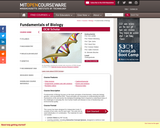
Fundamentals of Biology focuses on the basic principles of biochemistry, molecular biology, genetics, and recombinant DNA. These principles are necessary to understanding the basic mechanisms of life and anchor the biological knowledge that is required to understand many of the challenges in everyday life, from human health and disease to loss of biodiversity and environmental quality.

Build a gene network! The lac operon is a set of genes which are responsible for the metabolism of lactose in some bacterial cells. Explore the effects of mutations within the lac operon by adding or removing genes from the DNA.

Objective
Students will be able to use a textbook to gather information about the structure and function of the organs in the digestive system.
Big Idea
Food and oxygen follow a path to get to the cells.
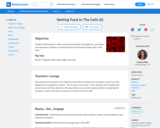
Objective
Students will be able to make connections between the digestive, circulatory and respiratory systems in understanding how food and oxygen gets to the cells.
Big Idea
Blood: A highway filled with oxygen and food.
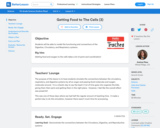
Objective
Students will be able to model the functioning and connections of the Digestive, Circulatory, and Respiratory systems.
Big Idea
Getting food and oxygen to the cells takes a lot of parts and coordination!
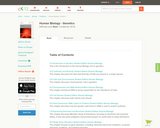
The Genetics Student Edition book is one of ten volumes making up the Human Biology curriculum, an interdisciplinary and inquiry-based approach to the study of life science.
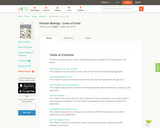
The Lives of Cells Student Edition book is one of ten volumes making up the Human Biology curriculum, an interdisciplinary and inquiry-based approach to the study of life science.